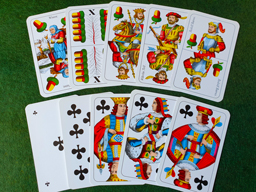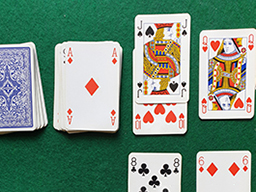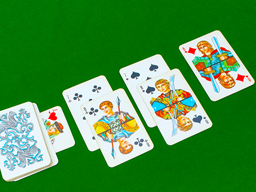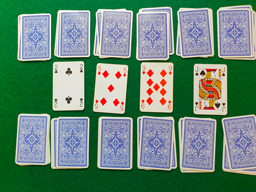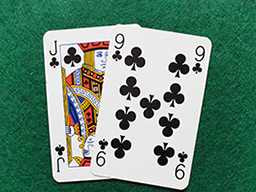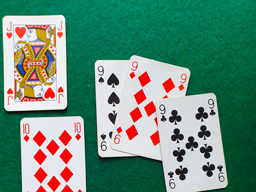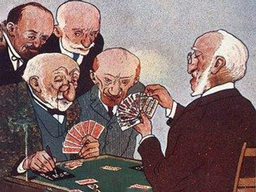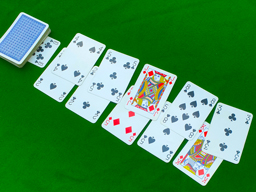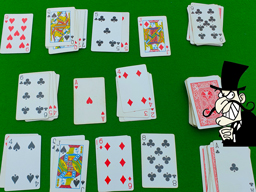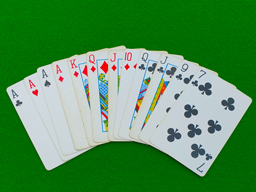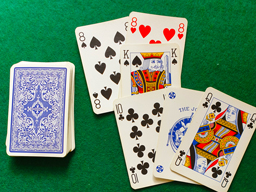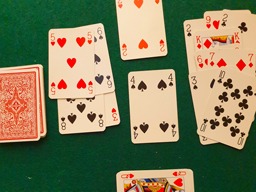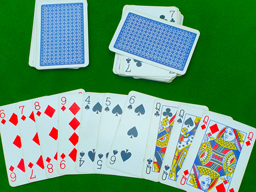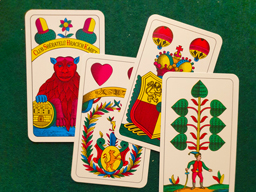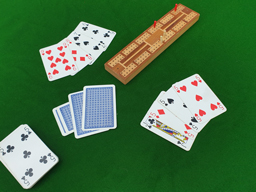Recommended Games for Two Players
A selection of some the best 2-player card games and domino games, recommended by the editor. For a longer list of traditional games, see the full 2-player game index. See also our recommended games for three, four, five and six players.
A two-player game in which the aim is to be the first to 66 points by taking tricks and declaring marriages. It is very popular in Austria where large tournaments are held. Related games are played in several other European countries.
This 2-player game which appeared in North America in the 1970's is slightly reminiscent of later commercially successful combat games such as Magic the Gathering though the similarity is probably a coincidence.
This is a version of the popular Russian card game Durak in which instead of beating an attack, the defender can transfer it to the next player by playing an equal card. This game works well with 2 players.
Spanish fishing game with 40 cards for 2-4 players. Cards are captured by making sets that add up to 15.
An ingenious two-player game by Eliott Adkins in which each player has a supply of 52 cards drawn one at a time and the object is to win the best of 11 poker hands.
A popular children's game in which players race to collect packets of four equal cards by exchanging cards one at a time with a row of four face up cards on the table.
A popular Korean game for 2 or 3 players using flower cards. Having collected enough scoring combinations to win, you have to decide whether to stop the game or try to improve your score at the risk of losing everything.
Variously known as Clobyosh, Kalabrias, Klabberjass or Bela, this point-trick game with melds is widely acknowledged as one of the most skilful two-player card games.
An enjoyable two-player game, good for passing the time on train and plane journeys. There are some players in California, but it is said to have originated in Mexico.
An American two-player cross domino game in which players score for making the ends of the layout add up to a multiple of 5.
A two-player trick and draw card game from Hungary also known as Felsős, in which sets of equal cards and sequences in suit can be collected and declared during the play.
This two-player card game from Afghanistan is featured in Khaled Hosseini's novel The Kite Runner. Panjpar means five cards, the number initially held by each player. The aim is to be the first to get rid of all your cards in the endgame, after the drawing deck runs out.
American game for two in which players compete to play their cards in numerical sequence to foundation piles. The skill is in the management of the reserve piles where currently unplayable cards are stored.
Classic game for two players, which has deservedly survived with very little change since the 16th century. There are scores for longest suit, best sequence, best set of 3 or 4 of a kind and for tricks.
A skilful adding game for 2 players, also playable by 3 or 4, in which players take turns to play cards totalling each number from 1 to 20. Contributed by Brian Stovel.
An unusual draw and discard game from Nepal, which has also become popular in Israel. Players get rid of their cards by discarding rummy-like combinations which they have collected.
In this unusual version of Casino played in Eswatini and Lesotho, players can steal cards from the top of their opponents' capture piles to help with building piles for later capture.
A skilful and popular American two-player 10-card rummy game. A player can risk ending the play when their unmatched cards (deadwood) are of sufficiently low value, or play on to try to match all their cards for a 'gin' bonus.
Popular Czech game for 2 or 4 players in which tricks are won by playing a card equal to the lead or a seven. The objective is to capture aces and tens.
Classic game in which players score on a peg board for making pairs, runs and sets of cards that add up to 15 during the play, in their hands, and in the 'crib'. From its British origins over 300 years ago this game has spread throught the English-apeaking world.
The above are the editor's recommendations, but tastes differ and you may prefer to explore the full index of traditional 2-player games. Further 2-player games can be found among the collection of invented games and on the commercial games page.
Explanation of symbols
Difficulty. Subjective assessment of the editor combining two factors: how difficult or complex the rules are, and how difficult it is to learn to play the game well.
Popularity. Games are ranked in order of the average number of people (actually different IP addresses) per month who visited the game rules page in the last 6 months. Top 10% get 5 hearts, next 10% 4 hearts, next 20% 3 hearts, next 30% 2 hearts, bottom 30% 1 heart. (The top 6 games under this ranking are also listed on the home page as 'most popular games'.)
Trend. The number of visitors in the most recent month is compared with the average per month over the preceding five months, and the significance of the change is estimated using a statistical technique described here. The pages are then ranked in order from most significant increase down to most significant decrease. The top 10% are given 5 flames, the next 20% 4 flames, the middle 40% 3 flames, the next 20% 2 flames and the bottom 10% 1 flame. (The 6 games or pages with the most significant increase are also listed on the home page under 'recent interest'.)
The stats and popularity/trend ratings are updated at the beginning of each month, and the order in which the recommended games are listed on this page is shuffled randomly once a week so as not to give undue weight to any one recommendation.
Notes on two-player games
There is a great demand for good two-player games, especially in Western countries where since the 20th century people have tended to seek entertainment at home rather than gather together in larger social groups. For card players in this situation it can be frustrating that most of the best card games require four, or sometimes three or five players.
People in this situation often look for ways to adapt these games for two, but this is problematic for games in which all the cards are dealt out. It is a characteristic of most good card games that the players begin with incomplete information about the distribution of the cards and discover more in the course of the play. But if all the cards are dealt to two players, each player knows from the start exactly what the other holds, and an important feature of the game is lost. So when creating two-player versions of games players look for ways to withhold some of this information, for example by dealing out only part of the deck to the players. The remainder may be left as an unknown dummy hand, or as a drawing stock from which hands are replenished during play.
But rather than playing something that is at best a poor imitation of a game for 3 or 4 players, it is generally more enjoyable to try a game that is designed for two, such as the games recommended above. These are all games of incomplete information, in the true traditional of cards games.
There are however a few two-player card games that are designed to be played with all the cards dealt out, so that each player has perfect knowledge of the positions of the cards. Some of these are games of bluff, introducing an element of uncertainty by requiring players to choose their move simultaneously. The best-known example of this is GOPS. Others have more of the character of perfect information board games or puzzles, in which by studying the position each player could in theory work out a perfect strategy, although the solution will be different for each deal. Notable examples are Mate and Besikovich's Game (a variant of Svoi Kozyri). Another interesting type of game is 24, where the cards are not dealt to the players at all: it is simply a challenge to be the first to produce the total 24 from the array of 4 cards on the table, and can be played by two or any other number of contestants.
